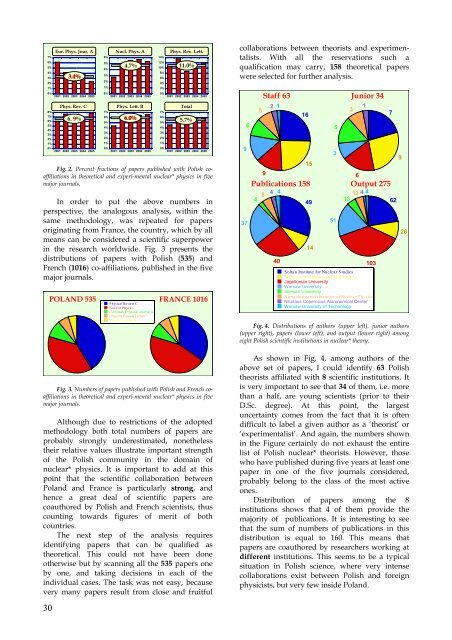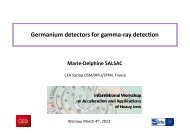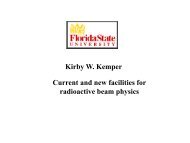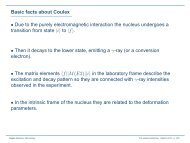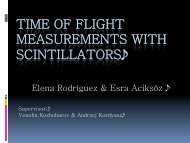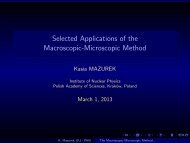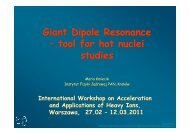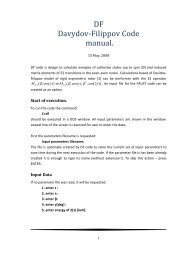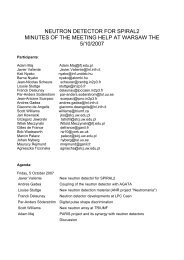nuclear physics in poland 1996 â 2006
nuclear physics in poland 1996 â 2006
nuclear physics in poland 1996 â 2006
- No tags were found...
You also want an ePaper? Increase the reach of your titles
YUMPU automatically turns print PDFs into web optimized ePapers that Google loves.
7%6%5%4%3%2%1%0%8%7%6%5%4%3%2%1%0%Eur. Phys. Jour. . A Nucl. Phys. . A Phys. Rev. Lett.3.4%2001 2002 2003 2004 20057%6%6. 9% 6.05%2001 2002 2003 2004 20056%5%4%3%2%1%0%4%3%2%1%0%2001 2002 2003 2004 20052001 2002 2003 2004 200514%12%4.7% 10%11.0%8%6%4%2%0%7%6%5%4%3%2%1%0%2001 2002 2003 2004 2005Phys. Rev. . C Phys. Lett. . B Total6.0%5.7%2001 2002 2003 2004 2005Fig. 2. Percent fractions of papers published with Polish coaffiliations<strong>in</strong> theoretical and experi-mental <strong>nuclear</strong>* <strong>physics</strong> <strong>in</strong> fivemajor journals.In order to put the above numbers <strong>in</strong>perspective, the analogous analysis, with<strong>in</strong> thesame methodology, was repeated for papersorig<strong>in</strong>at<strong>in</strong>g from France, the country, which by allmeans can be considered a scientific superpower<strong>in</strong> the research worldwide. Fig. 3 presents thedistributions of papers with Polish (535) andFrench (1016) co-affiliations, published <strong>in</strong> the fivemajor journals.POLAND 535 FRANCE 1016Physical Review CNuclear PhysicsEuropean Physical Journal APhysical Review LettersPhysics Letters Bcollaborations between theorists and experimentalists.With all the reservations such aqualification may carry, 158 theoretical paperswere selected for further analysis.93765Staff 63 Junior 3492 11615Publications 158 Output 2754 8 4 13 12 4 449511440103Sołtan Institute for Nuclear StudiesMa ria Curie -S kłodowska UniversityJagellonian UniversityWarsaw UniversitySilesian UniversityNiewodniczański Institute of Nuclear PhysicsNicolaus Copernicus Astronomical CenterWarsaw University of TechnologyFig. 4. Distributions of authors (upper left), junior authors(upper right), papers (lower left), and output (lower right) amongeight Polish scientific <strong>in</strong>stitutions <strong>in</strong> <strong>nuclear</strong>* theory.53361762926Fig. 3. Numbers of papers published with Polish and French coaffiliations<strong>in</strong> theoretical and experi-mental <strong>nuclear</strong>* <strong>physics</strong> <strong>in</strong> fivemajor journals.Although due to restrictions of the adoptedmethodology both total numbers of papers areprobably strongly underestimated, nonethelesstheir relative values illustrate important strengthof the Polish community <strong>in</strong> the doma<strong>in</strong> of<strong>nuclear</strong>* <strong>physics</strong>. It is important to add at thispo<strong>in</strong>t that the scientific collaboration betweenPoland and France is particularly strong, andhence a great deal of scientific papers arecoauthored by Polish and French scientists, thuscount<strong>in</strong>g towards figures of merit of bothcountries.The next step of the analysis requiresidentify<strong>in</strong>g papers that can be qualified astheoretical. This could not have been doneotherwise but by scann<strong>in</strong>g all the 535 papers oneby one, and tak<strong>in</strong>g decisions <strong>in</strong> each of the<strong>in</strong>dividual cases. The task was not easy, becausevery many papers result from close and fruitful30As shown <strong>in</strong> Fig, 4, among authors of theabove set of papers, I could identify 63 Polishtheorists affiliated with 8 scientific <strong>in</strong>stitutions. Itis very important to see that 34 of them, i.e. morethan a half, are young scientists (prior to theirD.Sc. degree). At this po<strong>in</strong>t, the largestuncerta<strong>in</strong>ty comes from the fact that it is oftendifficult to label a given author as a ‘theorist’ or‘experimentalist’. And aga<strong>in</strong>, the numbers shown<strong>in</strong> the Figure certa<strong>in</strong>ly do not exhaust the entirelist of Polish <strong>nuclear</strong>* theorists. However, thosewho have published dur<strong>in</strong>g five years at least onepaper <strong>in</strong> one of the five journals considered,probably belong to the class of the most activeones.Distribution of papers among the 8<strong>in</strong>stitutions shows that 4 of them provide themajority of publications. It is <strong>in</strong>terest<strong>in</strong>g to seethat the sum of numbers of publications <strong>in</strong> thisdistribution is equal to 160. This means thatpapers are coauthored by researchers work<strong>in</strong>g atdifferent <strong>in</strong>stitutions. This seems to be a typicalsituation <strong>in</strong> Polish science, where very <strong>in</strong>tensecollaborations exist between Polish and foreignphysicists, but very few <strong>in</strong>side Poland.


